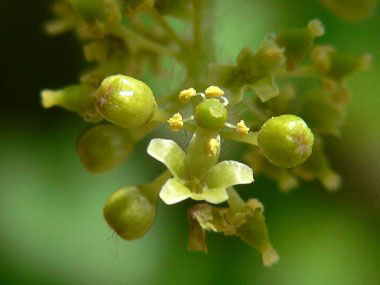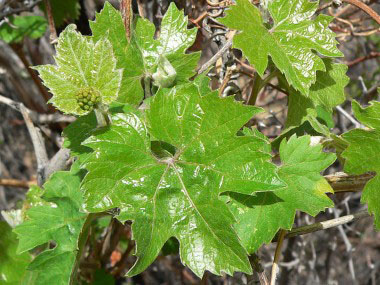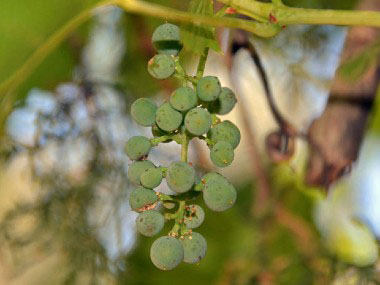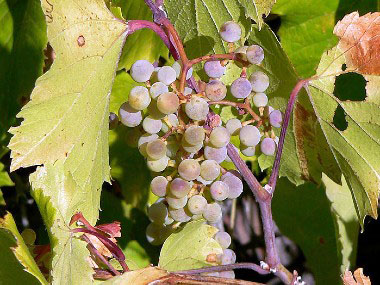





To support our efforts please browse our store (books with health benefits, etc.).
This wild grape vine is a perennial in the Vitaceae family and is commonly known as Jiragui, Uva del Monte, Uva Cimarrona, and Parra in Spanish. Being a vine, it is often found over rocks, shrubs and trees. Canyon Grape is a native grape to the southwest US and it was first cultivated by Pueblo Indians. This wild grape can be found across the southwestern United States and in parts of Mexico.
Distinguishing Features
Canyon grape vine has woody stems that grow quite long. The stems are able to stay secure because of forked tendrils at their tips. Leaves are somewhat heart-shaped and coarsely toothed. Tiny greenish flowers grow in long clusters and produce juicy dark purple grapes that are edible, although tart and seedy, but very popular with birds.
Flowers
Flowers tend to be white or greenish, and they are fragrant. Petals are partly united at flowering. Grape flowers are small, greenish, and borne in short panicles. Each has five petals that are fused at the tips into a cap that soon falls off to reveal a cluster of stamens (in male plants) or carpels (in female plants). Flowering season depends on location but typically is April to July (May to June in Texas).
 Fields
of Nutrition has medicinal benefits and vitamin/mineral content of Canyon Grape.
Fields
of Nutrition has medicinal benefits and vitamin/mineral content of Canyon Grape.
Leaves
The leaves have coarsely toothed margins and are dark green when mature. The large simple leaves are arranged alternately and typically have three shallow lobes. Leaves measure 3 to 12 cm (1 to 5") long with a similar or slightly larger width. Green leaves turn stunning shades of red in the fall.
Height
Canyon grape vine can climb to 5m (16') tall and it can also reach 5m (16') wide.
Habitat
It common grows along streams and shady canyons and in riparian areas, often climbing in trees. Canyon grape is native to Arizona, Texas, Utah and northern Mexico, growing between elevations of 2,000 and 7,500’.
Edible Parts
Ripe fruit is fairly small but useful in making juice, syrups, sweets and they can be dried for later use in the winter months. The fruit makes delicious preserves and wine. Leaves can be used to wrap foods and then baked. They impart a very pleasant taste when baked. They can be used in soups and stews as well. Young tendrils can be pickled or tossed into salads.
Other Name
Arizona Grape.
Similar Plants
All images courtesy of Stan Shebs: https://commons.wikimedia.org/wiki/User:Stan_Shebs.
Winter Survival Food Handbook

PDF Plant Magazines
Types of Wild Food
Geographic Zones Seasons
Disclaimer
EdibleWildFood.com is informational in nature. While we strive to be 100% accurate, it is solely up to the reader to ensure proper plant identification. Some wild plants are poisonous or can have serious adverse health effects.
We are not health professionals, medical doctors, nor are we nutritionists. It is up to the reader to verify nutritional information and health benefits with qualified professionals for all edible plants listed in this web site. Please click here for more information.
Why Edible Wild Food?
- Food costs are rising
- Free, wild food is readily abundant
- Wild food adds nutrition to your diet
- Wild food can help treat various medical conditions





